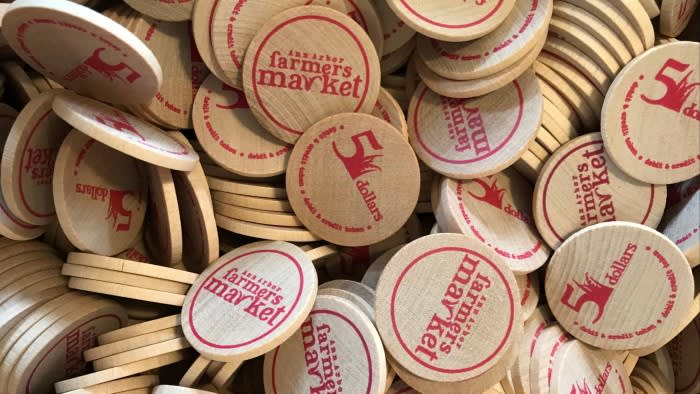Unlock the Editor’s Digest for free
Roula Khalaf, Editor of the FT, selects her favourite stories in this weekly newsletter.
The writer is an FT contributing editor
At the farmers’ market on Detroit Street in Ann Arbor, Michigan, there are three ways to pay. You can hand over cash. For some vendors, you can swipe a credit card at the stall. Or you can stop by the market office trailer, swipe a credit card and in exchange receive what the market informally calls wooden nickels — tokens, printed with the market’s logo, good for five American dollars.
American companies have handed out wooden nickels since the early 20th century, as tokens for store credit. During the Depression, a few communities relied briefly on the nickels as a circulating currency when local banks failed. Since then, they’ve functioned mostly as souvenirs. Anyone who grew up as a Boy Scout in America, for example, will remember collecting nickels at jamborees. The coins at the market in Ann Arbor were manufactured by the Old Time Wooden Nickel Company. As the name suggests, Old Time specialises in novelty coins for museums and events.
The value of the nickels in Ann Arbor rests in part on American nostalgia. But only in part. They are a real, functioning currency, managed with care and accounted for with precision by the city office that runs the market. When you present your credit card for nickels, the city pays the swipe fee, sparing farmers at the market the costs of America’s payments infrastructure. Historically, cities and states have used complementary currencies such as wood tokens or paper scrip when money is too tight, during a financial crisis. The fivers at the farmers’ market in Ann Arbor, however, solve a different problem: payments in America are too expensive, particularly for places like farmers’ markets, which in the past relied on dollar cash.
This week America’s Consumer Financial Protection Bureau released a set of rules to encourage open banking. If finalised, the rules would force banks to share their data with each other and third-party apps. The rules could also mark a first step towards allowing consumers to pay for vegetables or anything else through direct transfer from their bank accounts, an innovation long adopted in other countries. America’s mighty banking lobby has already announced its opposition, since the rules could also make it easier for consumers to take their deposits from one bank to another.
The wooden nickels in Ann Arbor show just how important it is to pry at the banks’ grip on American policy. Ann Arbor is not the only city to offer this service. The US Department of Agriculture doesn’t keep comprehensive records on swapping token money for credit cards at state and city-run markets, but other examples are easy to find — at the Crescent City Market in New Orleans, for example, or the Williamsburg Farmers’ Market in Virginia. The wooden nickels are an ingenious innovation to deal with federal shortcomings.
These cities didn’t adopt their own token currencies expressly to avoid swipe fees. Originally, they wanted to encourage more Americans on food assistance programmes to shop for fresh fruit and vegetables at local farmers’ markets. By the early 2000s, states and the federal government had completed a transition from offering physical coupons — what Americans used to call “food stamps” — to supplying Electronic Benefit Transfer cards, something like an ATM card for public benefits.
The new EBT cards presented a challenge to farmers’ markets. It was cumbersome and expensive to get accredited to accept them, so in the 2010s the markets began to take on the burden, to put local farmers on an even footing with supermarkets. The infrastructure, then, began as a way to adapt a federal benefits programme to local needs. Many states and cities will also match Federal benefit spending at local markets; the wooden nickel currency systems are an efficient way to introduce a subsidy.
According to the Department of Agriculture, more than 500 markets report accepting EBT at a central location. The EBT tokens are common enough that the Farmers Market Coalition, an advocacy group, has published guidelines for implementing them — offer both five- and one-dollar tokens, for example, so farmers don’t return change in hard-dollar cash.
Since food assistance can only be used for specific items, markets have to distinguish their EBT tokens from credit card tokens, using different colours. But both kinds of tokens suggest the same lack of infrastructure in America — insufficient wireless coverage, federal inattention to small vendors, inadequate banking rules. In America, even as people use fewer hard-dollar Federal Reserve notes, farmers’ markets still have to create something that looks an awful lot like cash.
https://www.ft.com/content/7c3d3093-4d8a-4c77-ae6d-f4079052d126


